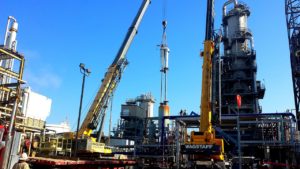 Considered an industry-standard, silicone O-rings hold excellent mechanical properties that perform in the most extreme conditions. Silicone materials, in general, are exceptionally versatile. The material is not only used in the fabrication of seals, gaskets, and O-rings, but in numerous other applications such as adhesives, lubricants, thermal and electrical insulation, and in medical devices, and cooking utensils.
Considered an industry-standard, silicone O-rings hold excellent mechanical properties that perform in the most extreme conditions. Silicone materials, in general, are exceptionally versatile. The material is not only used in the fabrication of seals, gaskets, and O-rings, but in numerous other applications such as adhesives, lubricants, thermal and electrical insulation, and in medical devices, and cooking utensils.
Recognized for its many diverse characteristics and rubber-like quality, silicone is a synthetic elastomeric compound. Technically, it is a polysiloxane, any of a class of fluids, resins, or elastomers made from polymerized siloxanes. In more general terms, it is made from a cross-linked polymer joined together with carbon, hydrogen, and oxygen molecules and reinforced with silica, a compound of silicon and oxygen. Thus, silicone rubber holds unique characteristics that consist of both inorganic and organic materials that provide a perfect balance of chemical and mechanical properties.
Though usually referred to as a rubber, silicone is an elastomeric polymer and synthetic compound that has properties of both rubber and plastic. For O-rings and other applications, silicone can be formulated to meet a variety of application requirements.
Key Factors to Consider When Choosing Silicone O-Rings
1. Different Types and Forms of Silicone
Depending on its viscosity and the method employed for processing, silicone rubber is available in four main forms:
- Fluorosilicone Rubber or FSR, is a durable, stable, long-lasting elastomer. Its most familiar application is for seals and O-rings, but it is also found in aerospace fuel system components, diaphragms, gaskets, and hose linings.
- HCR, High Consistency Rubber (or solid silicone rubber), also referred to as High-Temperature Vulcanized or HTV, contains polymers with a high molecular weight and relatively long polymer chains. This makes the material gummy in texture, with a high viscosity, having excellent resiliency and recovery after elongation and compression. It can be formulated with additives to modify its physical properties to meet specific application requirements.
- Unlike the molecular weight of HCR, Liquid Silicone Rubber, LSR, contains polymers of lower molecular weight and shorter chains, which provide better flow properties. It is a popular option for small molded components. It maintains its flexibility and elasticity in temperature range from -76°F to 482°F, which makes it an ideal choice for serving diverse applications such as high-power LED lighting, electronics, automotive lighting, and many others.
- Room Temperature Vulcanized or simply, RTV, is a liquid silicone rubber made from one-part (RTV-1) or two-component (RTV-2) systems where their hardness ranges from very soft to medium. RTV cures at room temperature and, once exposed to air, forms a flexible rubber. It can be used as an adhesive sealant, for molding, or as an electronic encapsulant potting compound.
2. Excellent Resistance Properties
Silicone is well-regarded for its high-performance properties. It provides thermal stability, flexibility, temperature resistance, and durability. The material functions in temperatures between -150°F and 550°F before it becomes too brittle or begins to melt. Additionally, it rebounds and compresses very well, with high tensile strength with a low compression set, making it ideal for compression force sealing and working among high-temperature extremes and pressures.
The material also offers heat and flame resistance which makes it an excellent electrical insulator. It bonds well with other metals, too. Because of its UV, ozone, and weather resistance properties, silicone performs admirably in outdoor conditions. Its water-resistant properties make it a choice material for use as a sealant in a variety of applications. For projects where water, moisture, and weather exposure are constant, be it submerged, semi-submerged, or in marine and aquatic environments, silicone provides sealing capabilities with a very strong adhesive bond. It can be used to waterproof and seal mechanical surfaces and repair cracks in different types of outdoor and indoor surfaces.
Silicone has hypoallergenic properties too, that, in combination with its thermal stability, and water and temperature resistance, make the material popular in medical O-ring applications as well as consumer and industrial food and beverage applications. In its sponge-like form, silicone rubber can reduce vibration and noise for use in transportation components.
3. Easily Customized to Meet Application Requirements
Because silicone’s base inorganic and organic properties offer stability when groups of organic molecules like methyl are added the material can be customized to meet certain application requirements. Methyl groups, under the name MQ, are the basic silicone rubbers that were first developed. They feature several variants with certain traits depending on the application. Methyl vinyl groups (VMQ) have good compression traits. Methyl phenyl (MPQ) and methyl phenyl vinyl (PVMQ) groups are used to increase silicone’s capabilities in low temperatures. Flouro, vinyl, and methyl (FVMQ) groups are used in applications that require more chemical resistance to oil, fuel, and solvents, such as O-rings, seals, and gaskets.
One of the most commonly used synthetic elastomers on the market, silicone rubber is a high-performance and highly versatile material. Offering thermal stability, flexibility, durability, and resistance to water and temperature extremes, UV, and ozone, silicone is valued for its many diverse mechanical properties which make it the leading material of choice for O-rings and other sealing products. Its unique characteristics make it ideally suited for the most demanding applications.


